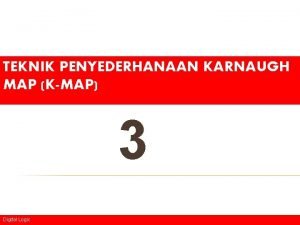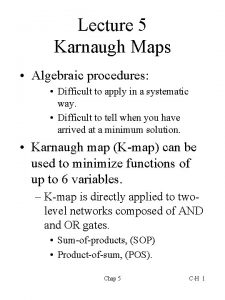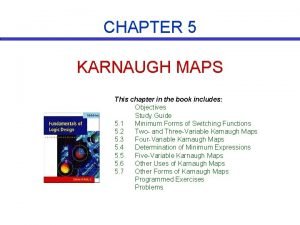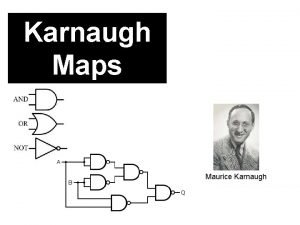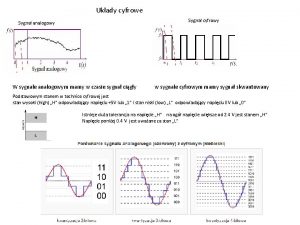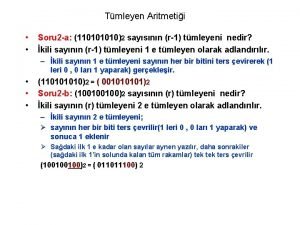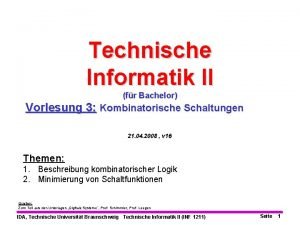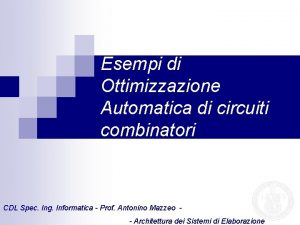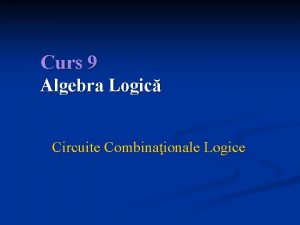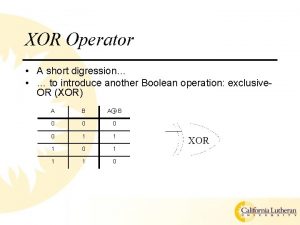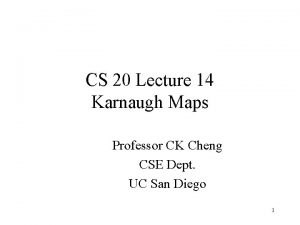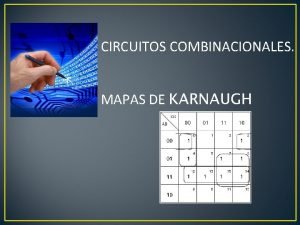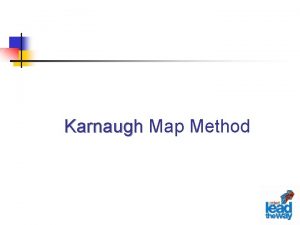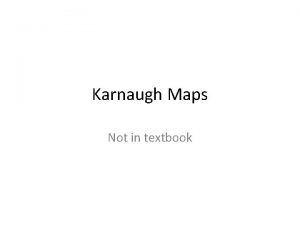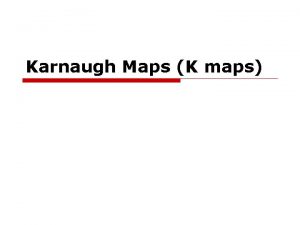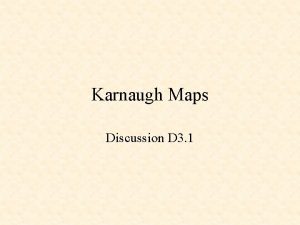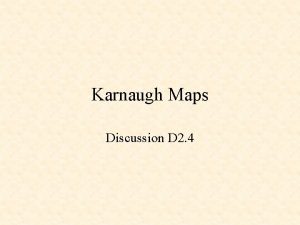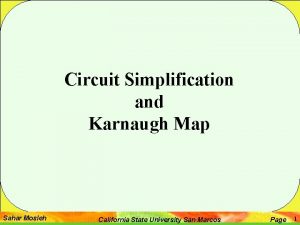Chapter 3 The Karnaugh Map Copyright The Mc

































- Slides: 33

Chapter 3 The Karnaugh Map Copyright © The Mc. Graw-Hill Companies, Inc. Permission required for reproduction or display.




An implicant of a function is a product term. From the point of view of the map, an implicant is a rectangle of 1, 2, 4, 8, . . . (any power of 2) 1’s. That rectangle may not include any 0’s. The implicants of F are Minterms A´B´C´D´ A´B´CD A´BCD ABC´D´ ABC´D ABCD AB´CD Groups of 2 A´CD BCD ACD B´CD ABC´ ABD Groups of 4 CD

A prime implicant is an implicant that (from the point of view of the map) is not fully contained in any one other implicant. An essential prime implicant is a prime implicant that includes at least one 1 that is not included in any other prime implicant.


Map Method 1 1. Find all essential prime implicants. Circle them on the map and mark the minterm(s) that make them essential with an asterisk (*). Do this by examining each 1 on the map that has not already been circled. It is usually quickest to start with the most isolated 1’s, that is, those that have the fewest adjacent squares with 1’s in them. 2. Find enough other prime implicants to cover the function. Do this using two criteria: a. Choose a prime implicant that covers as many new 1’s (that is, those not already covered by a chosen prime implicant). b. Avoid leaving isolated uncovered 1’s.

f = y´z´ + wyz + w´xz minimum all prime implicants

x´yz´ + x´yz + xy´z´ + xy´z + xyz x´ y + x y´ + x z x´ y + x y´ + y z

not used minimum G = A´BC´ + A´CD + ABC + AC´D

g = xz + w´yz´ + wx´y g = xz + w´yz´ + x´yz´ g = xz + wz + x´yz´ + w´xy

F = A´C´D´ + AC´D + A´CD + ACD´ + … F = A´C´D´ + AC´D + A´CD + ACD´ + B´D´ + AB´ F = A´C´D´ + AC´D + A´CD + ACD´ + B´C F = A´C´D´ + AC´D + A´CD + ACD´ + AB´ + B´C

Map Method 2 1. Circle all of the prime implicants. 2. Select all essential prime implicants; they are easily identified by finding 1’s that have only been circled once. 3. Then choose enough of the other prime implicants (as in Method 1). Of course, these prime implicants have already been identified in step 1.

f = a´c´d´ + bc´d + acd + b´cd´ f = a´b´d´ + a´bc´ + abd + ab´c

f = a´c´d´ + bc´d + acd + b´cd´

A prime implicant is a rectangle of 1, 2, 4, 8, … 1’s or X’s not included in any one larger rectangle. Thus, from the point of view of finding prime implicants, X’s (don’t cares) are treated as 1’s. An essential prime implicant is a prime implicant that covers at least one 1 not covered by any other prime implicant (as always). Don’t cares (X’s) do not make a prime implicant essential.

minimum F = BD + A´C´D + AB´C other p. i. s


Finding a minimum product of sums expression requires no new theory. The following approach is the simplest: 1. Map the complement of the function. (If there is already a map for the function, replace all 0’s by 1’s, all 1’s by 0’s and leave X’s unchanged. ) 2. Find the minimum sum of products expression for the complement of the function (using the techniques of the last two sections). 3. Use De. Morgan’s theorem (P 11) to complement that expression, producing a product of sums expression.





F = A´B´C + A´BE + AB´C´E´ + ABCD´E´ + BDE

F = A´C´E´ + ABCD + CD´E + BCE + B´C´DE´ + A´CD´ F = A´C´E´ + ABCD + CD´E + BCE + B´C´DE´ + A´D´E´


F = A´C´ + AB G = A´C + AB


F = A´B´ + ABC´ G = A´B + BC´



F = B´C + AB´C´ + A´BD + ABD G = C + A´BD H = BC + AB´C + ABD
 Karnaugh map pos minimization
Karnaugh map pos minimization Penyederhanaan karnaugh map
Penyederhanaan karnaugh map Penyederhanaan dengan karnaugh map f = ab' + a'b + ab
Penyederhanaan dengan karnaugh map f = ab' + a'b + ab Karnaugh map probability
Karnaugh map probability Karnaugh map examples exercises
Karnaugh map examples exercises Karnaugh map examples exercises
Karnaugh map examples exercises Karnaugh map
Karnaugh map 16 bit alu
16 bit alu Karnaugh map examples exercises
Karnaugh map examples exercises Karnaugh map
Karnaugh map Penyederhanaan dalam peta karnaugh
Penyederhanaan dalam peta karnaugh Maurice karnaugh
Maurice karnaugh Peta karnaugh 3 variabel
Peta karnaugh 3 variabel Maurice karnaugh
Maurice karnaugh Mapa de karnaugh 3 variables
Mapa de karnaugh 3 variables Circuito
Circuito Phương pháp quine mccluskey
Phương pháp quine mccluskey Wyświetlacz 7-segmentowy tablica karnaugh
Wyświetlacz 7-segmentowy tablica karnaugh R-1 tümleyeni
R-1 tümleyeni Kv diagramm 3 variablen
Kv diagramm 3 variablen Peta
Peta Mappe di karnaugh esempi
Mappe di karnaugh esempi Tabel de adevar cu 3 variabile
Tabel de adevar cu 3 variabile Karnaugh kmap xor patterns
Karnaugh kmap xor patterns Maxtermos e mintermos
Maxtermos e mintermos Karnaugh tábla
Karnaugh tábla Karnaugh diyagramı
Karnaugh diyagramı Tableau de karnaugh online
Tableau de karnaugh online Mappe di karnaugh spiegazione
Mappe di karnaugh spiegazione Veitch-karnaugh
Veitch-karnaugh Karnaugh maps
Karnaugh maps Calcular mapa de karnaugh
Calcular mapa de karnaugh Karnaugh
Karnaugh Aljabar boolean matematika diskrit
Aljabar boolean matematika diskrit


